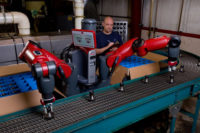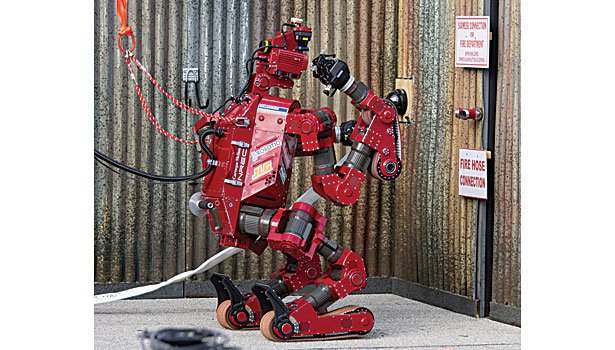CHIMP driven to win DARPA robotics challenge

The CHIMP robot completes one of eight tasks at DARPA’s Robotics Challenge trials. It finished in third place and will participate in the challenge finals this December. Photo courtesy www.darpa.mil

Kollmorgen provided 49 motors for CHIMP, including 42 in one of four custom sizes and seven modified standard models. Photo courtesy Kollmorgen


Last December, U.S. Defense Advanced Research Projects Agency (DARPA) hosted the trials of its first ever Robotics Challenge at the Homestead Speedway in Miami, FL. DARPA announced the competition in October 2012 in response to the Fukushima, Japan Dachai nuclear accident on March 11, 2011.
There, robots were ill-equipped to assess the disaster, inspect the facility and fix problems. The purpose of the challenge is to develop semi-autonomous ground robots that can do complex tasks in dangerous and degraded human-engineered environments.
Eight robots will participate in the finals, including CHIMP, which stands for CMU Highly Intelligent Mobile Platform. It was designed and built by Tartan Rescue, a partnership of the National Robotics Engineering Center (NREC) and several technology suppliers, including Kollmorgen. NREC is the applied research and technology transfer organization of Carnegie Mellon University’s Robotics Institute.
Each of CHIMP’s drive joints feature Kollmorgen’s KBM frameless motors integrated with gearing and housing components. This design gives each joint 50 degrees of freedom, enabling the robot to perform advanced mobility, multi-limb manipulation and human-like grasping capabilities.
Kollmorgen provided 49 motors for CHIMP, including 42 in one of four custom sizes and seven modified standard models. Company and NREC engineers worked closely together to develop the high power joint used in many locations throughout the robot.
“The CHIMP design explicitly avoids many of the dynamic stability issues associated with humanoid robots,” says Steve DiAntonio, development director for NERC. “Tracks on all four limbs provide CHIMP with better mobility and stability while opening doors, using tools and turning valves.”
DiAntonio says that sensors at the head and limbs provide the perception and feedback needed for CHIMP to manipulate objects, remove debris and travel safely through the environment. The robot’s hardware components and software methods are standalone technologies that offer new automation capabilities for facility maintenance, material handling and manufacturing, including robots used in parts picking, small parts assembly and high-strength maneuvers.
NREC engineers like that KBM motors allow direct load connection, eliminating maintenance of gearboxes, belts or pulleys. They also like the motors’ high performance and responsiveness with zero backlash.
CHIMP overcame two major hurdles to reach the finals. The first was qualifying for the challenge trials by receiving a positive Critical Design Review by DARPA in June 2013. At the trials, CHIMP took third place out of 16 robots. The top eight qualified for the finals.
Each robot completed a series of specific tasks using standard tools and equipment commonly available in human environments, including:
- Driving a vehicle at the site.
- Dismounting and traveling across rubble.
- Removing debris blocking an entryway.
- Opening a door and entering a building.
- Climbing a ladder and traversing a walkway.
- Using a tool to break through a concrete panel.
- Locating and closing a valve near a leaking pipe.
- Replacing a component, such as a cooling pump.
Tartan Rescue has received DARPA funding since its establishment. Like the other finals-qualifying teams, Tartan will receive up to $1 million dollars in additional DARPA funding to further refine the capabilities of CHIMP.
For more information on frameless motor technology, call 540-633-3545 or visit www.kollmorgen.com.
Looking for a reprint of this article?
From high-res PDFs to custom plaques, order your copy today!








